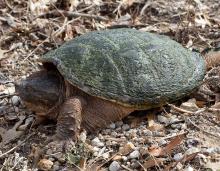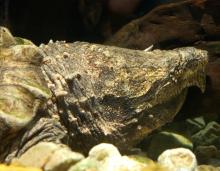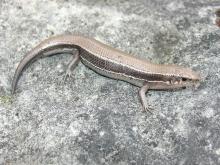Reptiles and Amphibians
Media

Species Types
Scientific Name
Chelydra serpentina
Description
A large aquatic turtle with a big pointed head, long thick tail, and small lower shell, the eastern snapping turtle is common throughout the state, anywhere there is permanent water.
Media

Species Types
Scientific Name
Macrochelys temminckii
Description
In Missouri, alligator snapping turtles are protected, and it is illegal to harvest them. This species is totally aquatic and rarely leaves the water. In Missouri, it mainly occurs in the large rivers, sloughs, and oxbow lakes of our southern, southeastern, and eastern counties.
Media

Species Types
Scientific Name
Storeria dekayi
Description
Dekay's brownsnake is a small, secretive species that prefers moist environments. It can be gray to brown to reddish brown. It usually has a tan stripe running down the back, bordered by two rows of small brown spots. The top of the head is usually dark. Occurs statewide.
Media

Species Types
Scientific Name
Plestiodon anthracinus pluvialis
Description
The southern coal skink is secretive. It lives in the southern half of Missouri, excluding the Bootheel. Adults are small, shiny, and brownish, with a wide, coal-black line on the side. Juveniles are black with faint lines down the back and sides and a blue-gray tail.
Media

Species Types
Scientific Name
Agkistrodon piscivorus
Description
The cottonmouth is named for the cotton-white lining of its mouth, which it opens widely when alarmed. This dangerously venomous, semiaquatic snake occurs in the southeastern corner of Missouri, with a spotty distribution in the Ozark Region.
Media

Species Types
Scientific Name
Clonophis kirtlandii
Description
Kirtland’s snake is extremely rare and occurs in only a few states in the Midwest. It lives in crayfish burrows in grassland habitats that are damp and near a stream or wetland. It is restricted in Missouri to a few northeastern counties.
Media

Species Types
Scientific Name
Nerodia fasciata confluens
Description
The broad-banded watersnake is a semiaquatic snake with broad, irregularly shaped bands that can be brown, reddish brown, or black and are separated by yellow or gray. This nonvenomous species is restricted to the southeastern corner of the state.
Media

Species Types
Scientific Name
Nerodia rhombifer rhombifer
Description
The northern diamond-backed watersnake is our largest watersnake. It has numerous diamond-shaped light markings along the back. It occurs in the Bootheel and north along the Mississippi River, and in much of northern and western Missouri. It doesn’t occur in the Ozarks or in much of central-eastern Missouri.
Media

Species Types
Scientific Name
Nerodia sipedon sipedon (northern watersnake) and N. s. pleuralis (midland watersnake)
Description
The northern watersnake and midland watersnake are Missouri's two subspecies of common watersnake. Together they occur statewide. Color is variable: gray, tan, or reddish brown with dark crossbands or blotches. The belly is cream-colored with red, brown, or black spots or half-moon markings.
Media

Species Types
Scientific Name
Nerodia erythrogaster
Description
The plain-bellied watersnake is a medium-sized, heavy-bodied, dark-colored, semiaquatic snake with a plain yellow belly. It's present in the Bootheel and north along the Mississippi River floodplain, and along our southernmost counties and northward in western Missouri into parts of northwest Missouri.
See Also
About Reptiles and Amphibians in Missouri
Missouri’s herptiles comprise 43 amphibians and 75 reptiles. Amphibians, including salamanders, toads, and frogs, are vertebrate animals that spend at least part of their life cycle in water. They usually have moist skin, lack scales or claws, and are ectothermal (cold-blooded), so they do not produce their own body heat the way birds and mammals do. Reptiles, including turtles, lizards, and snakes, are also vertebrates, and most are ectothermal, but unlike amphibians, reptiles have dry skin with scales, the ones with legs have claws, and they do not have to live part of their lives in water.





















